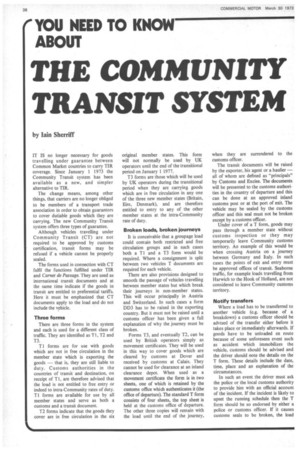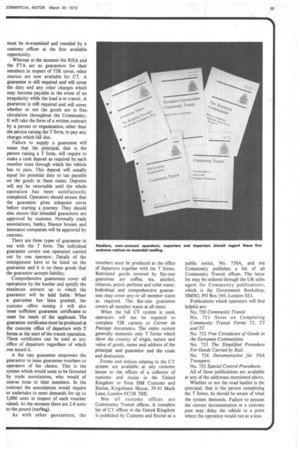r YOU NEED TO KNOW
Page 38

Page 39

If you've noticed an error in this article please click here to report it so we can fix it.
ABOUT
THE COMMUNITY TRANSIT SYSTEM
by kin Sheniff
IT IS no longer necessary for goods travelling under guarantee between Common Market countries to carry TIR coverage. Since January 1 1973 the Community Transit system has been available as a new, and simpler alternative to TIR.
The change means, among other things, that carriers are no longer obliged to be members of a transport trade association in order to obtain guarantors to cover dutiable goods which they are carrying. The new Community Transit system offers three types of guarantee.
Although vehicles travelling under Community Transit (CT) are not required to be approved by customs certification, transit forms may be refused if a vehicle cannot be properly sealed.
The forms used in connection with CT fulfil the functions fulfilled under TIR and Carnet de Passage. They are used as international transit documents and at the same time indicate if the goods in transit are entitled to preferential tariffs. Here it must be emphasized that CT documents apply to the load and do not include the vehicle.
Three forms There are three forms in the system and each is used for a different class of traffic. They are identified as TI, T2 and 13.
Ti forms are for use with goods which are not in free circulation in the member state which is exporting the goods — that is, they are still liable to duty. Customs authorities in the countries of transit and destination, on receipt of Ti, are therefore advised that the load is not entitled to free entry or indeed to intra-Community rates of duty. Ti forms are available for use by all member states and serve as both a customs and a transit document.
T2 forms indicate that the goods they cover are in free circulation in the six original member states. This form will not normally be used by UK operators until the end of the transitional period on January 11977, T3 forms are those which will be used by UK operators during the transitional period when they are carrying goods which are in free circulation in any one of the three new member states (Britain, Eire, Denmark), and are therefore entitled to entry to any of the other member states at the intra-Community rate of duty.
Broken loads, broken journeys It is conceivable that a groupage load could contain both restricted and free circulation groups and in such cases both a TI and a 13 form would be required. Where a consignment is split between two vehicles T documents are required for each vehicle.
There are also provisions designed to smooth the passage of vehicles travelling between member states but which break their journeys in non-member states. This will occur principally in Austria and Switzerland. In such cases a form DD3 has to be raised in the exporting country. But it must not be raised until a customs officer has been given a full explanation of why the journey must be broken.
Forms T3, and eventually T2, can be used by British operators simply as movement certificates. They will be used in this way to cover goods which are cleared by customs at Dover and received by customs at Calais. They cannot be used for clearance at an inland clearance depot. When used as a movement certificate the form is in two sheets, one of which is retained by the customs office which authenticates it (the office of departure). The standard T form consists of four sheets, the top sheet is held at the customs office of departure. The other three copies will remain with the load until the end of the journey, when they are surrendered to the customs officer.
The transit documents will be raised by the exporter, his agent or a haulier — all of whom are defined as "principals" by Customs and Excise. The documents will be presented to the customs authorities in the country of departure and this can be done at an approved inland customs post or at the port of exit. The vehicle may be sealed by the customs officer and this seal must not be broken except by a customs officer.
Under cover of a T form, goods may pass through a member state without customs inspection or they may temporarily leave Community customs territory. An example of this would be when crossing Austria on a journey between Germany and Italy. In such cases the points of exit and entry must be approved offices of transit. Seaborne traffic, for example loads travelling from Harwich to the Hook of Holland, are not considered to leave Community customs territory.
Notify transfers Where a load has to be transferred to another vehicle (e.g. because of a breakdown) a customs officer should be advised of the transfer either before it takes place or immediately afterwards. If goods have to be unloaded en route because of some unforeseen event such as accident which immobilizes the vehicle, customs should be advised and the driver should note the details on the T form. These details include the date, time, place and an explanation of the circumstances.
In such an event the driver must ask the police or the local customs authority to provide him with an official account of the incident. If the incident is likely to upset the running schedule then the T form should be so endorsed by either a police or customs officer. If it causes customs seals to be broken, the load must be re-examined and resealed by a customs officer at the first available opportunity.
Whereas at the moment the RI-IA and the FTA act as guarantors for their members in respect of TIR cover, other sources are now available for CT. A guarantee is still required and will cover the duty and any other charges which may become payable in the event of an irregularity while the load is in transit. A guarantee is still required and will cover whether or not the goods are in freecirculation throughout the Community. It will take the form of a written contract by a person or organization, other than the person raising the T form, to pay any charges which fall due.
Failure to supply a guarantee will mean that the principal, that is the person raising a T form, will require to make a cash deposit as required by each member state through which the vehicle has to pass. This deposit will usually equal the potential duty or tax payable on the goods in these states. Deposits will not be returnable until the whole operation has been satisfactorily completed. Operators should ensure that the guarantee gives adequate cover before starting a journey. They should also ensure that intended guarantors are approved by customs. Normally trade associations, banks, finance houses and insurance companies will be approved by customs.
There are three types of guarantee in use with the T form. The individual guarantee covers one operation carried out by one operator. Details of the consignment have to be listed on the guarantee and it is on these goods that the guarantor accepts liability.
Comprehensive guarantees cover all operations by the haulier and specify the maximum amount up to which the guarantor will be held liable. When a guarantee has been granted, the customs office issuing it will also issue sufficient guarantee certificates to meet the needs of the applicant. The guarantee certificates must be produced at the customs office of departure with T forms at the start of the transit operation. These certificates can be used at any office of departure regardless of which one issued it.
A flat rate guarantee empowers the guarantor to issue guarantee vouchers to operators of his choice. This is the system which would seem to be favoured by trade associations, who would of course issue to their members. In the contract the associations would require to undertake to meet demands for up to 5,000 units in respect of each voucher raised. At the moment there are 2.4 units to the pound (sterling).
As with other guarantees, the vouchers must be produced at the office of departure together with the T forms. Restricted goods covered by flat-rate guarantee are coffee, tea, alcohol, tobacco, petrol, perfume and toilet water. Individual and comprehensive guarantees may cover any or all member states as required. The flat-rate guarantee covers all member states at all times.
When the full CT system is used, operators will not be required to complete TIR carnets or Carnet de Passage documents. The entire system generally demands only T forms which show the country of origin, nature and value of goods. name and address of the principal and guarantor and the route and destination.
Forms and notices relating to the CT system are available at any customs house or the offices of a collector of customs and excise in the United Kingdom or from HM Customs and Excise, Kingsbeam House, 39-41 Mark Lane, London EC3R 7HE.
Not all customs offices are Community Transit offices. A complete list of CT offices in the United Kingdom is published by Customs and Excise as a
public notice, No. 750A, and the Community publishes a list of all Community Transit offices. The latter list may be ordered through the UK sales agent for Community publications, which is the Government Bookshop, HMSO, PO Box 569, London SEL
Publications which operators will find helpful are: No. 750 Community Transit No. 751 Notes on Completing Community Transit Forms TI, T2 and T3 No. 752 Free Circulation of Goods in the European Communities.
No. 753 The Simplified Procedure For Goods Carried by Rail.
No. 754 Documentation for Fish Transport.
No, 755 Special Control Procedures All of these publications are available at any of the addresses mentioned above.
Whether or not the road haulier is the principal, that is the person completing the T forms, he should be aware of what the system demands. Failure to present the correct documentation at a customs post may delay the vehicle to a point where the operation would run at a loss.










































































































